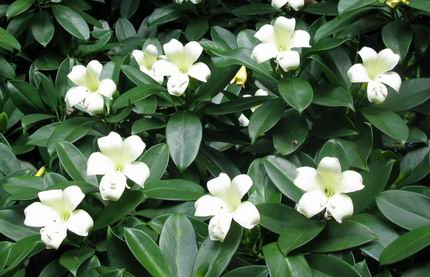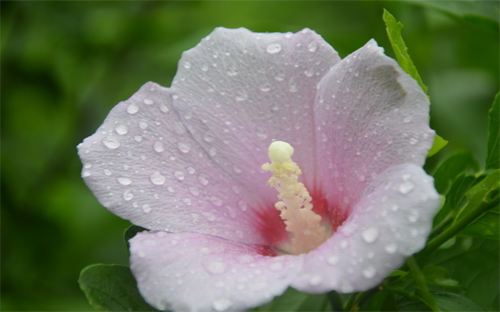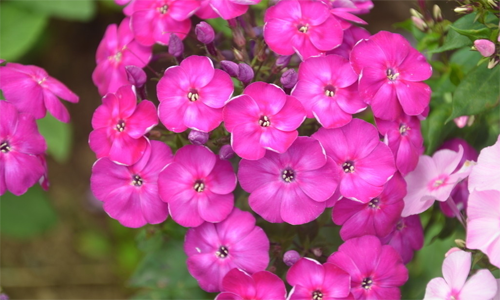Breeding methods and precautions of African jasmine how to reproduce and prune
African jasmine is also a kind of jasmine, open small white flowers, a bit like sweet-scented osmanthus flowers, African jasmine breeding methods and precautions are what? How does African jasmine reproduce?

Culture methods and precautions of African jasmine:
1. Soil selection
Its biggest requirement for soil is good soaking, naturally choose loose, fertile sandy soil, generally can be mixed with rotten leaf soil and fine sand, it is better to add organic fertilizer properly.
If the soil is hardened, loosen the topsoil a little bit from time to time, and be careful not to hurt the roots.
2. Moisture
It likes Rain Water's ample, sunny environment, but the roots can not accumulate water, it is easy to rot the roots, and watering too frequently will lead to yellow leaves.
Watering can be dry and thoroughly watered, hot summer can be sprayed once in the morning and evening, humidification and cooling (summer exposure leaves will wilt, move the flowerpot to the shade to spray water, soon can be restored).
In winter, you don't have to water it. The soil is dry for a few days, and you can water it a little on a fine sunny day.
3. Light and temperature
It likes warm, sunny environment, overwintering environment is higher than 5 degrees, the growth temperature is 17-35 degrees.
If there is a high temperature of 40 degrees in summer, we should also pay attention to shade, potted plants can not be exposed to the sun, it is more hardy, the temperature below 3 degrees should be moved into the indoor or covered with soil, cover film insulation.
Pay attention to the lighting problem is mainly, do not suddenly take the indoor potted plants to the sun, or summer is too hot to pay attention to shade. Don't put the potted plants in too dark places.
4. Fertilization
Fertilizing can be done in spring, summer and autumn. Generally, give phosphorus and potassium fertilizer once before May to promote flowering. Give phosphorus and potassium fertilizer again after flowering to survive the winter safely, two or three times a year!
5. Pruning
Proper pruning not only makes African jasmine more beautiful, but also blooms more flowers and reduces diseases and insects.
It is a small shrub with fast branches and resistance to pruning, so it can be properly shaped after flowering, and it can be shaped according to its own ideas.
Propagation methods of African jasmine:
The general method of propagation of African jasmine is cutting, while sowing is usually used for seedling breeding and large-scale propagation.
1. Cuttage propagation
African jasmine can be cut except in winter, generally June to July is the most suitable, August to September in the south is also very good, it is best to choose rainy days, choose 1-2-year-old strong branches of 10 cm 15 cm cuttings, remove the lower leaves, leave 1 to 2 pairs of leaves. Peat soil with perlite or fine sand, vermiculite cuttings, covered with plastic film, plus proper shade, take root soon after a month.
2. Ramet propagation
Ramet is generally combined with the warm spring to change the basin, shake off the soil and separate the roots (cut with a sterilized sharp knife), each ramet with 2-3 rhizomes, and another cuttage can be made.
3. Striping propagation
Generally speaking, it is the ground pressure. The 2-3-year-old branch ring is peeled and buried in the soil to cover the soil.
Cut off at the end of summer and then another kind of can, the effect is the best, the operation is not difficult.
High-altitude striping propagation can also be carried out at the end of spring, generally select 2-3-year-old branches, select 1 cm under the growth node, ring-cut (peel) and then wrap the moist peat soil with plastic film to keep the soil slightly moist.
4. Sowing and reproduction
After autumn, the seeds were collected, dried and sown, and the sandy soil was slightly moisturized, moisturized and sowed.
Pest control of African jasmine:
1. Anthrax
Anthrax is more common, in twigs and leaves will see grayish brown sunken spots, there will also be black dots.
Generally, it is necessary to clean up the diseased leaves and spray carbendazim and chlorothalonil. The effect of alternating spraying is the best, spraying alternately every 10 days, 3 times and 4 times.
2. Sunburn
Now is the extremely hot time, pot maintenance will be sunburn, the common wilt moved to a cool place to spray water.
If it is young leaves, twigs sunburn, there are white marks, then it is necessary to cut off the sunburned twigs and leaves, spray water, ventilation and shade.
3. Insect pests
Thrips often harm young leaves and buds. If you see inexplicably twisted or curled leaves, be sure to check carefully to see if they have worms, and check carefully at the back of the leaves and branches. Clean up the branches and leaves of the worms in time, and do not leave sick leaves and withered branches in the basin soil.
Serious cases should be combined with spraying, you can spray Skynet, Jinzun and other pesticides, spray every 6-7 days, even spray 3-4 times.
African jasmine breeding methods and reproduction and pruning methods are introduced here, quickly in their own home to raise a few plants.
Culture methods and points for attention of African jasmine pruning methods of African jasmine
African jasmine in the breeding process, need to be pruned according to the situation, first of all, do you know the African jasmine breeding methods and matters needing attention? Is there still a way to trim African jasmine? Today, let's talk about these two problems.
Culture methods of African jasmine:
1. Temperature. African jasmine grows well in warm climate, and the suitable growth temperature is from 18 ℃ to 32 ℃. When the summer temperature is higher than 38 ℃, it will inhibit plant growth. Some areas of South China can survive the winter in the open field, while pot cultivation in the north of the Yangtze River requires that the greenhouse temperature is not lower than 3 ℃ to 5 ℃ in winter.
2. Light. African jasmine likes the sun, and the primary environment is mostly in a semi-shaded state. South China is planted as a garden greening tree, and it is best to choose a place with side shade; potted plants in the north of the Yangtze River can receive full light in spring and autumn, and shade is required in summer. Or put it in the shade of big trees, at least avoid direct sunlight for several hours before and after noon. It is particularly noteworthy that the temperature rose sharply and the light was very strong on a sunny day after a long rain from June to July. Shading must be done to prevent young shoots and leaves from being burned. Potted plants in public places are required to have sufficient scattered light, or placed near the window, should not be too dark, otherwise lead to leaf loss of green yellowing or shedding.
3. Moisture. No matter on the ground or in the pot, sufficient water is required, but the roots must not accumulate water, otherwise they are easy to rot. Watering in spring and autumn to keep the basin soil moist; beware of stagnant water in plum rain season; in hot summer, spray water once in the morning and afternoon to humidify and cool down; for indoor potted plants in winter, it is appropriate to keep the pot soil slightly tide. and spray water to the leaves when the temperature is relatively high around noon. In spring, summer and autumn, under the condition of normal fertilization, if the lower leaves of potted plants turn yellow and fall off, it is likely to be due to stagnant water and rotten roots, so it is necessary to turn the basin and change the soil in time; in summer, if you are negligent in watering, when the newly drawn tender shoots wilt and droop, you can not immediately water the basin soil, but spray some water to the leaves first, and then pour appropriate amount of water to the basin soil after the leaves have recovered a little.
4. Soil. Planting in the southern region requires that the planting site is loose, fertile and well-drained sandy loam. Potted plants in the north can be prepared with 7 parts of rotten leaf soil, 1 part of river sand, 1 part of retted organic fertilizer and 1 part of fermented sawdust. During the growing season, the potted plants were loosened once a month to keep their roots in a good state of penetration. In addition, the soil of potted plants can be changed every 1 to 2 years.
5. Fertilizer. Potted plants applied thin mature cake fertilizer and water once a month in the growing season, and phosphorus and potassium fertilizer before flowering in May to promote plant flowering. After autumn, they applied phosphate and potassium fertilizer 1 or 2 times to pass the winter safely. Potted plants in northern China, in order to prevent leaf yellowing, 0.2% ferrous sulfate was added during the growing season. When planting in the ground, it is necessary to apply sufficient base fertilizer, and at the end of autumn, cake fertilizer is applied to the outside of the root system, 0.5 to 1 kg per plant.
Notes for African jasmine:
African jasmine is a sun-loving tree species, not herbaceous plants, but a small Arbor family, so it is only necessary to pay attention to the light when it is domesticated, and proper light every day is one of the necessary factors to ensure its healthy growth.
The most difficult time of African jasmine in winter, if there is no good protection, it will lead to slow growth in the coming year. Especially in the north, indoor heat preservation is needed in winter to ensure that the growth environment is not less than 5-10 ℃.
African jasmine rarely gets sick after growing up, but there are many diseases during its growth, such as yellowing and blackening of leaves, or burns of young leaves due to too strong light. Therefore, in the growing period, the need for careful care, pests can be properly sprayed, mostly anthrax, symptoms of small black spots on the leaves, the emergence of gray-white situation. There is usually a special potion to buy. Burn generally take more watering, more shade way to improve.
Pruning methods of African jasmine:
African jasmine is usually treated with heart-picking during the growing period, so that it does not affect viewing. If the lower leaves fall off seriously, re-cutting must be carried out. The specific method is to put the plant under suitable environmental conditions about half a month in advance (such as sufficient sunlight in spring or scattered light in summer), and appropriate amount of fertilizer to promote growth. When the growth is normal after half a month, each branch should be truncated, and the position of the truncation should depend on the size of the plant. The general interception length is about 15 cm, or it can be retained to 30 cm.
The watering times can be controlled after pruning. Due to the reduction or disappearance of leaves, the transpiration is very low and the water demand is not large. But after each watering, it is best to choose fertilizer and water irrigation, with the growth of new branches and leaves, fertilizer and water management can be increased.
Potted African jasmine flowers should generally be changed once a year. When changing the basin, part of the old soil and residual roots around the jasmine root system were removed and replaced with a new culture soil to improve the soil aggregate structure and nutrients, which was beneficial to the growth of jasmine. When you change the basin, water it thoroughly as if it were on the basin, so that the root soil can be connected closely and the growth can be restored. Before changing the basin, the jasmine should be trimmed once, leaving only about 10 cm for the branches born last year, and cut off the diseased and withered branches and the over-dense and thin branches. During the growing period, the old leaves that are too dense are often removed, which can promote the germination of axillary buds and the emergence of new branches and long buds.
More information on the culture methods and precautions of African jasmine
Jasmine is a very beautiful plant, like the sun, most of the time it was born in India. However, there is a variety of jasmine born in Africa, which is called African jasmine. Let's take a look at the farming methods and precautions we need to know if we grow African jasmine.
Culture methods and matters needing attention of African jasmine
I. the culture method of African jasmine-- light
African jasmine likes the sun very much and is suitable for growing in hot, humid and ventilated places. Jasmine likes the light and taboos cold at the same time. Therefore, it is not very appropriate to grow African jasmine in winter. African jasmine should strengthen its warm treatment in winter. If there is plenty of sunshine during the day, it can be placed outside. But be sure to move back to your room at night to keep warm.
2. The culture method of African jasmine-- water
Because African jasmine is an African variety, it is resistant to drought but avoid stagnant water at the same time. Jasmine flowers can be watered once in summer and sprayed to increase humidity when the weather is especially dry. African jasmine goes dormant in winter.
III. The cultivation method of African jasmine-soil
African jasmine needs certain nutrients to grow, so some excipients need to be added to the soil to increase nutrients, and humus can be selected with slight acidity.
4. The culture method of African jasmine-pruning
African jasmine grows rapidly, so we should pay attention to pruning at any time to ensure that the plant type of African jasmine becomes beautiful and generous.
- Prev

What are the culture methods and points for attention of hibiscus flower pruning methods
Hibiscus flowers are favored by many people, as long as they are in the ground, you can see hibiscus flowers bloom every year. What are the breeding methods and precautions for hibiscus flowers? What is the method of breeding?
- Next

What is the breeding method and price of Beautiful Sakura
Beauty Sakura, as soon as I see this name, I have a question in my heart. What is the relationship between Sakura and cherry blossoms? The flowers of Beautiful Sakura are indeed very similar to those of cherry blossoms. What is the breeding method of Beautiful Sakura? What is the price of Beautiful Sakura? The breeding method of Beautiful Sakura: beautiful cherry likes sunshine and is not tolerant to shade.
Related
- Fuxing push coffee new agricultural production and marketing class: lack of small-scale processing plants
- Jujube rice field leisure farm deep ploughing Yilan for five years to create a space for organic food and play
- Nongyu Farm-A trial of organic papaya for brave women with advanced technology
- Four points for attention in the prevention and control of diseases and insect pests of edible fungi
- How to add nutrient solution to Edible Fungi
- Is there any good way to control edible fungus mites?
- Open Inoculation Technology of Edible Fungi
- Is there any clever way to use fertilizer for edible fungus in winter?
- What agents are used to kill the pathogens of edible fungi in the mushroom shed?
- Rapid drying of Edible Fungi

